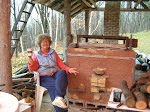I think that we all felt this was a difficult theme and most of us had a hard time thinking about what to make (apart from canoes). I spent many months mulling over ideas, looking up historical facts and so for me it ended up being a very enriching experience. Often when I look out over the river, I try to imagine all those huge voyageur canoes battling head winds and waves as they paddle their furs to Montreal.
What the jury focused on was:
1. Works that are stylistically or thematically focused on the Canoe Culture themes of water transportation in northern Ontario and how stops along this ancient waterway shaped the communities of Deep River and North Bay.
2. Works that display technical acumen, and/or observation and original style.
3. Works that are important to the cultural discourse of the region.
We were all allowed 4 entries and below are my four entries that were accepted.
My work for this exhibit was inspired by the Ottawa River, the fur trade and the design of the "made beaver" - the stretched beaver pelt dried on a wooden frame made by bending and lashing together branches into a circle.
Over 400 years have passed since the first Europeans traveled the Ottawa by canoe to North Bay, driven at first by a search for a route to China and then for furs, especially beaver pelts that were eventually felted into hats for European customers. For 200 years the stretched and dried beaver pelt - the "made beaver" - was the "currency" in trading with first nations inhabitants.
 |
| "One Made Beaver" - Eva Gallagher, Deep River |
Made Beaver Currency
1 MB = 1 brass kettle
= 20 fish hooks
= 2 1b of sugar
= 8 knives
= 20 flints
2 MB = 1 gallon brandy
20 MB = 1 rifle
Taking into account inflation the price of “one made beaver” in today’s’ dollars would be about $45.
 |
| "La Riviere Creuse - From Beavers of Atoms:" - Eva Gallagher, Deep River Riviere creuse is French for deep river and it is what this part of the Ottawa River was called by the early travelers.) |
 |
| "Portage" - Eva Gallagher, Deep River (Didn't have back drop wide enough for picture.) |
 |
| "Voyageur's Tribute" - Eva Gallagher, Deep River. Stoneware with beaver-chewed stick, stone and leather cording. |















